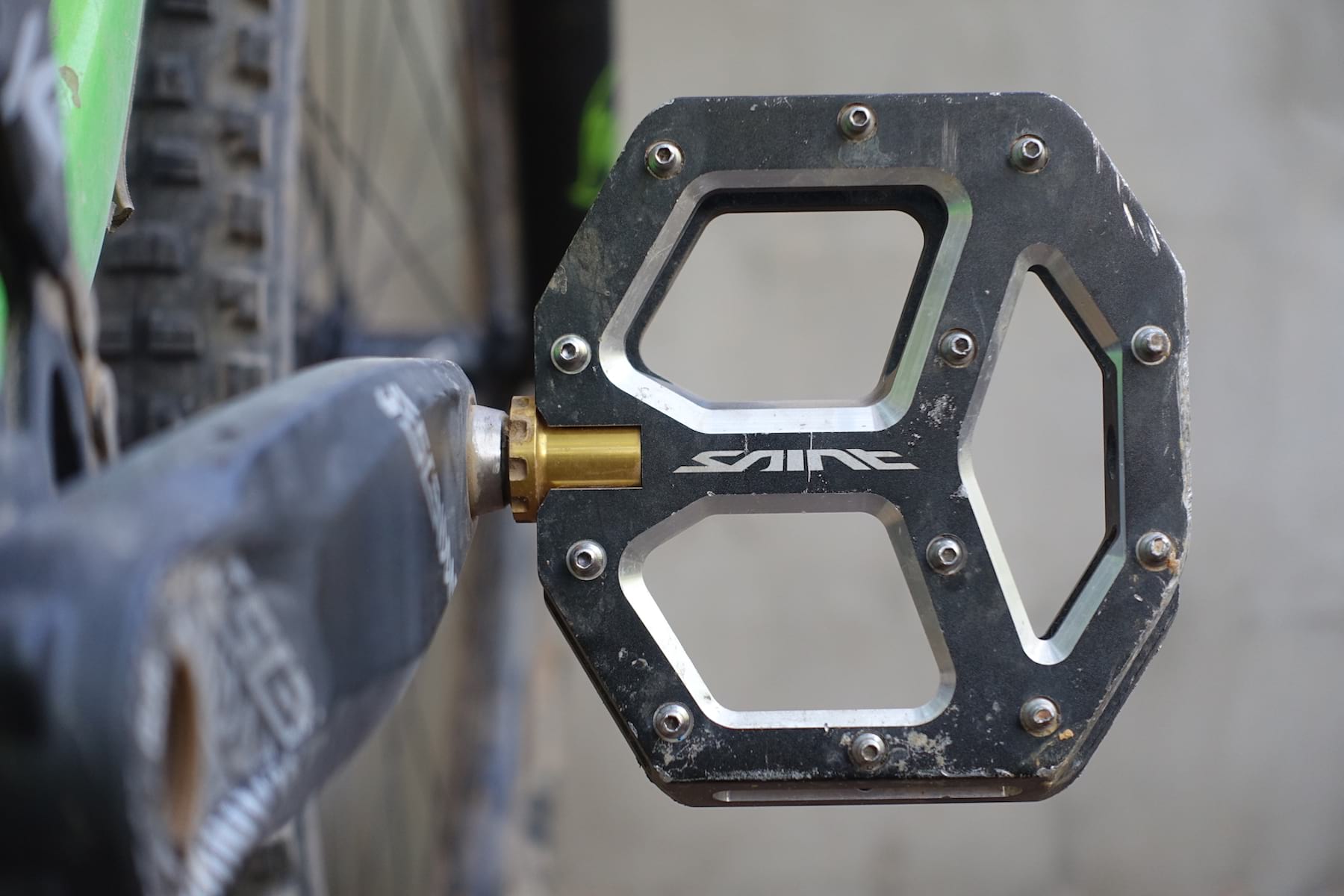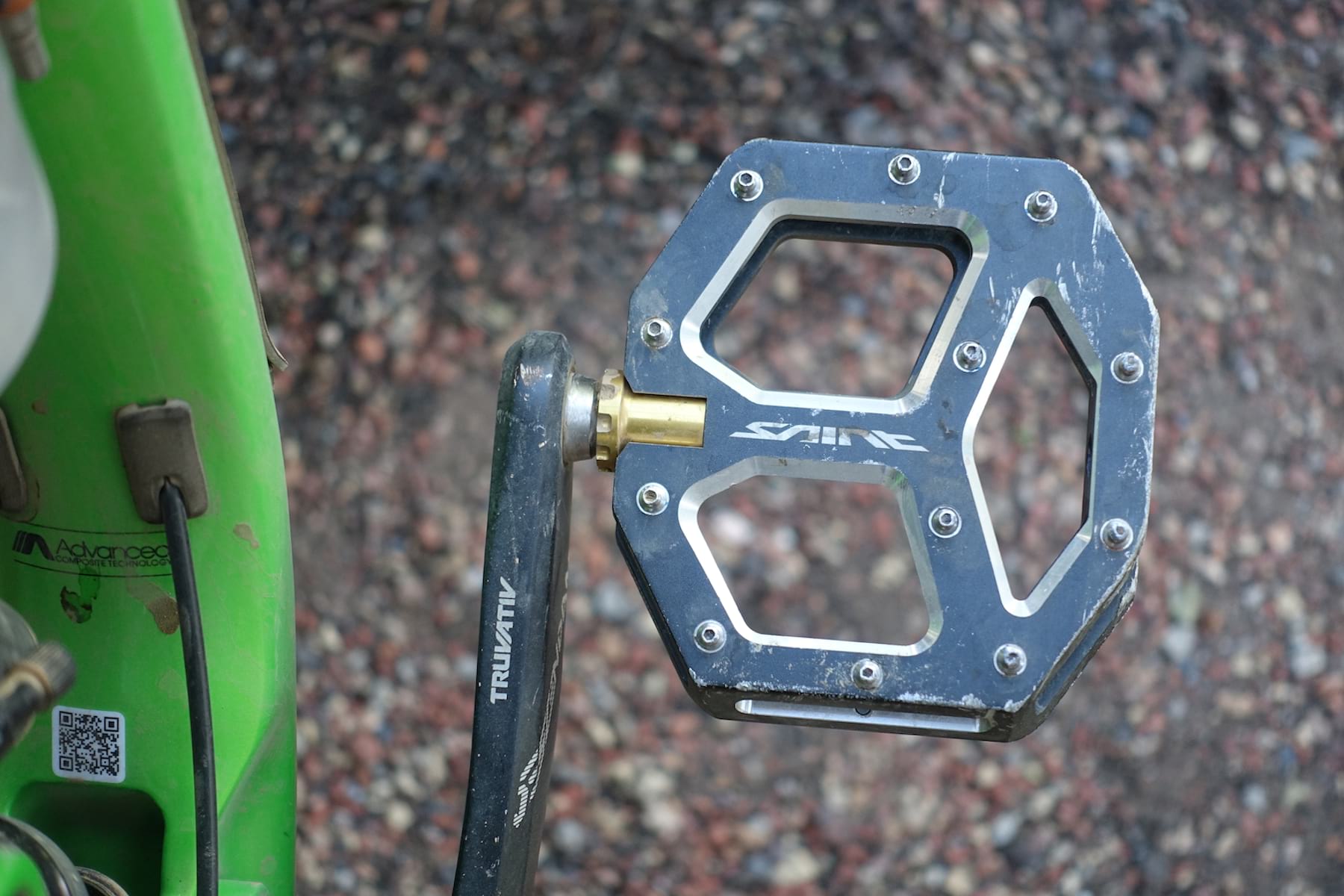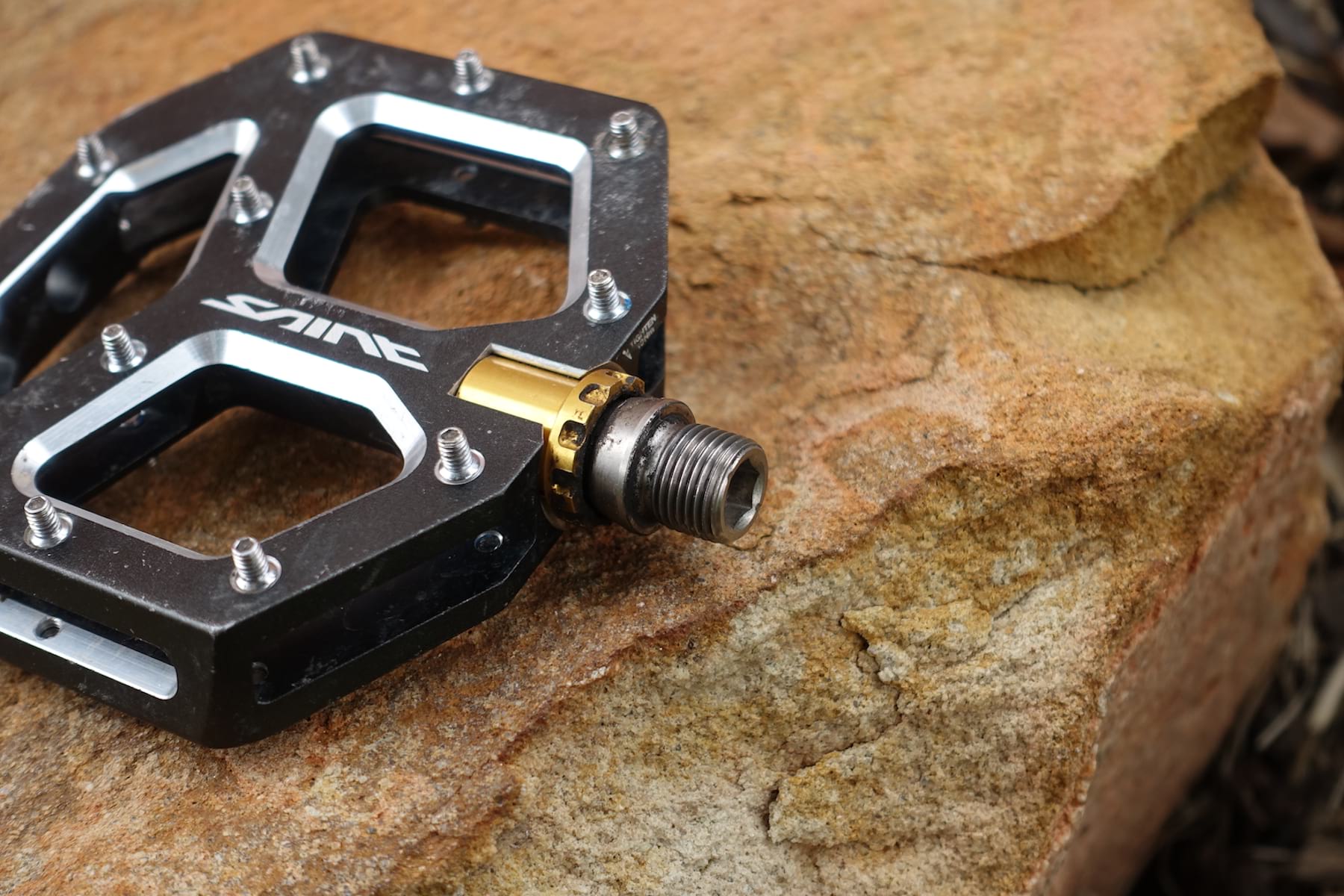For over a quarter of a century, Shimano has held an unwavering reputation for producing some of the most functional and durable clip-in mountain bike pedals on the market.
Curiously, the dominating popularity of its SPD system hasn’t exactly translated through to its flat pedal range though.
The previous Saint MX80 wasn’t a bad flat pedal. We published a longterm review (as in, 3-years of abuse) of the MX80, where we praised the durability of Shimano’s cup & cone bearing system, but lamented the small-but-thick platform and below-par traction levels.
Given how many great flat pedals are already out there (and there are a lot), Shimano realised it had to do better. And so a bit over a year ago, the Japanese brand unveiled the fully redesigned Saint M828 flat pedal.
Flat Earthers
At the same time, Shimano also released its first ever Deore XT flat pedal.
I tested and reviewed those last year, and they performed well in a utilitarian type fashion. I like that Shimano offers two different sizes in the XTs, with the larger of the two offering a big platform with loads of support. And the bearings were also solid and easy to rebuild. But the platforms were quite thick (18mm at the centre, 20mm at the front and back), which meant I smacked them around a lot, bending pins and fatally damaging a couple of the threaded bores in the process.
Though the Saint M828 shares some common features with the XTs, there are some notable differences.
For a start, the bodies are less bulky. Measuring 16.4mm thick through the centre, they’re a lick thinner than a set of DMR Vaults (17mm). However, they’re still thicker than Hope F20s (15mm), Gamut Podiums (10mm), and OneUp flats (8.3mm). Part of this is due to Shimano’s axle and bearing system though, which we’ll come back to.
Stone-Cold Tough
In typical Shimano fashion, the bodies themselves aren’t CNC milled like most other flat pedals. Instead, they’re built from tough hunks of cold-forged alloy, which are then post-machined to create classy smooth silver cutouts. This creates three large windows for mud to evacuate, though hollowed pockets around the body’s perimeter do create convenient shelves for storing soil samples.
Compared to the Large size XTs, the platform length stays pretty much the same at 109mm, but crucially, the width tightens in to 105mm. For my size 45 shoes, this is pretty close to perfect. Along with the thinner body, it’s meant I haven’t clipped these nearly as often, particularly when pedalling through deep ruts.
There’s a very slight amount of concavity to the body, with the front and rear increasing in thickness to 18mm. The octagonal platform is pretty flat and square overall though, especially compared to the bowl-like shape of the aforementioned Vaults.
As we’ve found out though, there is room for modification with the pins.
Pointy Pins
Shimano ships the Saint flats installed with 12 pins per side – two more than the XTs.
The stock 3mm pins leave a lot to be desired traction wise though. To be fair, I can see a lot of Saint pedals ending up on entry-level mountain bikes and e-MTBs. Not everyone wants to start out on SPDs after all, and beginner riders won’t necessarily want sharp stabby pins.
I’m obvs a shredder though, so for maximum grip I swapped all the 3mm pins with the supplied 5mm alternatives. Aside from being taller, these pins are externally threaded all the way up to create more biting edges.
Pin removal is a time-consuming process with a tiny 2mm hex key, since the threads are heavily dosed with Loctite. On the plus side though, I haven’t lost a single one during the test period.
Custom Traction
My colleague Andi has also been testing a set of Saints, and he’s running the taller 5mm pins on the front and rear of the platform, though he’s kept the shorter 3mm pins through the centre. This creates a pseudo bowl shape, enhancing concavity and allowing your shoe to sink into the pedal a little further.
Speaking of pins, I was initially concerned that they were of the grub screw variety, and not the thru-pin design found on DMR Vaults, Nukeproof Horizons, and Shimano’s previous Saint MX80s. This means when you do scrape them against a slab of granite – as I have so graciously done on many occasions – you’re actually grinding away the hex-shaped hole to remove them. Instead, you’ll have to use pliers for that job.
However, removing the Saint’s busted grub screws won’t damage the threads in the process – something that can happen with a bent thru-pin. Even still, I’d love to see Shimano spec pins with an additional socket-head base, like those found on Syntace pedals.
When it comes time for a refresher, spare pins can be had in a packet of 12 for a few quid. Because they use a standard M4 thread though, you can experiment with running whatever aftermarket pins you like.
Belting Bearings
I’d say the biggest strength of the Saints is the bearing quality. Despite the thrashing our test pedals have endured over the past nine months in all the weathers, the axles are still spinning as smooth as they were when new. Seriously.
Shimano has continued with its tried and tested cup ‘n’ cone bearing design, which sees two rows of 11 steel ball bearings housed inside each pedal. It’s entirely possible to pull the axle assembly apart to clean out and re-grease those bearings, but so far that need hasn’t arisen.

Of course the large bearing diameter prevents Shimano from making the Saints any thinner than they are. But compared to the tiny cartridge bearing and bushing systems than many other flat pedals use, this kind of bombproof reliability is not only impressive, it’s thoroughly welcome too.
If the bearings ever do get a bit scratchy, spare ball bearings can be sourced through Shimano, as can whole axle rebuild kits.

Under The Foot
Compared to the old Saint pedals and their 90x95mm platform, the 109x105mm platform of the M828s is much broader and more consistent in its profile.
Gone is the annoying axle bulge of the old design, made possible by a slimmer chromoly axle. The axle is beefier than what you’ll find on the XTs though, as Shimano wanted to ensure the Saints would be up to the demands of full-blown downhill riding.
Traction levels are good, if not class-leading. In my experience, I’ve found both the Vaults and Horizons to offer more bite. However, the Saints are noticeably grippier than Crank Brothers’ Stamp 7 pedals and with two more pins per pedal, per side, they’ve got more grip over the Deore XTs.
You can still easily reposition your foot while pedalling though, which I’ve found useful for long distance trail riding endeavours.
We’ve tested the Saints with a variety of shoes, including various 5.10s, Bontrager Flatlines, and Shimano GR7s. The latter has been a fantastic match in particular (as you’d expect) with the wide, flat and textured Michelin rubber soles delivering useful surface contact with plenty of edges to mate up with the tall 5mm pins.
The bodies are holding up well to a barrage of rock strikes, with the gently chamfered edges helping them to slide rather than smack. Of course a thinner pedal will avoid more rock strikes in the first place, and so far I’ve been impressed with how much abuse the Saints have shrugged off.
Despite bending and shearing down a few pins, I’ve also not had any of the fatal damage that I experienced with the Deore XTs.
At a confirmed 495g (including a full complement of 5mm pins), they’re certainly heavier alongside Gamut’s sub-300g Podiums. But then Shimano has clearly placed the emphasis on durability here.
Overall
The Saint M828s are a wholeheartedly bomber flat pedal that plays well to the Japanese brand’s strengths.
They’re not the lightest, thinnest or absolute grippiest pedals out there, and lovers of deeply concave platforms will still want to look elsewhere.
However, they do provide well-rounded performance. And if you want toughness and no-nonsense durability, there are few flat pedals out there that can match the Saint’s nonchalant performance. Factor in the ease of service, the availability of spare parts and the 2-year warranty, and these are about as trustworthy as it gets.
Want to see more flat pedal reviews? Then check out our 17-pedal group test right here!


















This is all well and good, but what happened to Wil’s moustache?